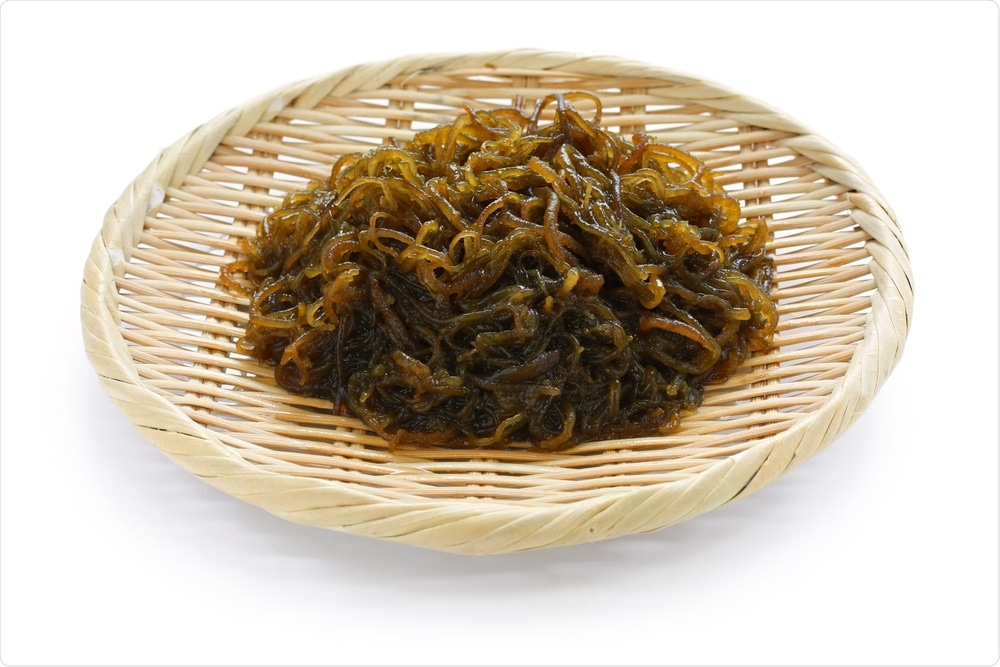Jun 26 2020
Since the 1980s, in seaweed farms dotted along the coastline of the subtropical islands of Okinawa, farmers have cultivated the edible brown alga, Okinawa mozuku (Cladosiphon okamuranus).

Image Credit:
Popular in Japanese cuisine, this superfood produces high levels of fucoidan - a slimy substance that has a myriad of health benefits, including the suppression of blood clots and tumors.
Every year, farmers harvest over 15,000 tons of this brown algae crop, contributing billions of Japanese Yen to the local economy. However, this once bountiful yield is now suffering due to increasingly warm, acidic and polluted waters.
In 2016, researchers from the Marine Genomics Unit at the Okinawa Institute of Science and Technology Graduate University (OIST) deciphered the genome of the S-strain, the first strain of Okinawa mozuku that was developed, shedding light on the molecular underpinnings of this brown seaweed.
Now, OIST researchers have decoded the genomes of three more strains - the O-strain, the C-strain and the K-strain. Their findings, published in BMC Genomics, could help the Okinawan seaweed farming industry adapt to growing environmental stresses, as well as providing novel insights into the underlying biology of brown algae.
"Despite the ecological and economic importance of brown algae, very little genetic research has been conducted so far, with researchers focusing more on their morphology, taxonomy or ability to regenerate," said Dr. Nishitsuji, first author and staff scientist from the Marine Genomics Unit.
"This is partly because of difficulties in extracting DNA and RNA from algal cells due to the accumulation of polysaccharides - long carbohydrate chains - in their cell walls."
But Dr. Nishitsuji believes that obtaining basic genomic information is essential to improve cultivation methods and to characterize each strain, with the OIST Marine Genomics Unit spearheading this effort.
In 2019, Dr. Nishitsuji and his then-colleague Dr. Asuka Arimoto were awarded the Okinawa Research Encouragement Prize as recognition for their contribution to Okinawa for their work on deciphering the genomes of many algal crops, including Okinawa mozuku.
As far as we are aware, only seven brown algae genomes have been published worldwide, and OIST decoded five of these genomes,"
Dr. Nishitsuji
Extracting genomic secrets
The scientists were provided with samples of the four strains from the Okinawa Prefectural Fisheries Research and Extension Center. They estimated that the draft genomes of the K-, 0- and C- strains contained 12,511, 12,548, and 12,182 genes that coded for proteins, respectively. For the S-strain, they also modified their previous estimate of 13,460 protein-coding genes down to 12,999.
After decoding the genomes, the researchers used sequences of nuclear and mitochondrial DNA to investigate how each strain of Okinawa mozuku evolved. They found that the four strains likely diverged at different times, with the S-strain diverging first, followed by the K-strain.
The researchers believe that the O-strain and the C-strain evolved the most recently. During diversification, each strain developed its own unique morphology.
When the scientists compared the whole genomes, they found that each strain was more genetically distinct than expected, with around 2-3.5% of genes that were unique to each strain.
"To put this into context, only around 0.79% of genes in Arabidopsis thaliana, the most well-studied land plant, are unique to each strain," said Dr. Nishitsuji.
The level of genetic difference that we see in Okinawa mozuku is far higher, potentially providing a case for classifying each strain as its own subspecies. This could have exciting economic benefits, as it could allow farmers to market their own unique, genetically distinct brands of Okinawa mozuku."
Due to a lack of genetic data on brown algae, the researchers have not yet pinned down the functions of these unique genes. However, they hope that further study could help identify whether some of these unique genes are involved in morphological variation or changes in physiology, which could provide different levels of tolerance towards environmental stresses, like heat or acidity.
Combating the threats of climate change
The threat of climate change and growing levels of ocean pollution and acidification are the main driving force behind the unit's investigations into the genetics of Okinawa mozuku.
"The genic and genomic information we have acquired could help us identify strains of Okinawa mozuku that are more tolerant to heat, and which underlying genes provide this valuable property," explained Dr. Nishitsuji.
Ultimately, the unit aims to develop new strains that are tolerant to the effects of climate change by cross-breeding existing strains together. While crossbreeding is commonplace for land plants, it has so far been unsuccessful in algae.
To achieve this feat, the team first plans to develop genetic markers to distinguish both the sex and strain of the algal cells involved in reproduction.
"Not only could this research help improve cultivation of mozuku in Okinawa, but it also has global implications, contributing towards a number of United Nation's Sustainable Development goals," added Dr. Nishitsuji.
For example, as a carbon-negative crop, seaweed farming has the potential to help mitigate climate change, and in the future, it could be an important marine resource for growing food sustainably.
Maintaining production and improving the cultivation of Okinawa mozuku, along with other edible seaweeds is, therefore, the main priority,"
Dr. Nishitsuji